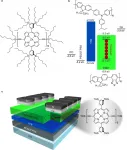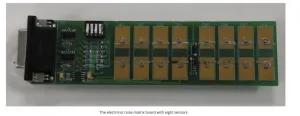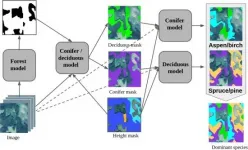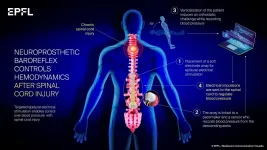(Press-News.org) Science is society's best method for understanding the world. Yet many scientists are unhappy with the way it works, and there are growing concerns that there is something "broken" in current scientific practice. Many of the rules and procedures that are meant to promote innovative research are little more than historical precedents with little reason to suppose they encourage efficient or reliable discoveries. Worse, they can have perverse side-effects that harm both science and scientists. A well-known example is the general preference for positive over negative results, which creates a "publication bias" that gives the false impression that certain effects exist where in reality the dissenting evidence simply fails to be released.
Arizona State University researchers Thomas Morgan and Minhua Yan, working with ASU graduate Leonid Tiokhin, now at University of Technology Eindhoven in the Netherlands, have developed a new model, published this week in Nature Human Behavior, to better understand the challenges facing the scientific process and how we can make it better. They focused on the "priority rule": the tendency for the first scientist to document a finding to be disproportionately rewarded with prestige, prizes and career opportunities while those in second place get little to no recognition.
Winner takes all
Many scientists have sleepless nights worrying about being "scooped" -- fearing that their work won't be considered "novel" enough for the highest-impact scientific journals because a different group working on the same topic manages to publish first. The priority rule has been around for centuries. In the 17th century, Newton and Leibniz haggled over who invented calculus. And in the 19th century, Charles Darwin rushed to publish of "The Origin of Species" to avoid being scooped by Alfred Russel Wallace.
"Rewarding priority is understandable and has some benefits. However, it comes at a cost," says Tiokhin. "Rewards for priority may tempt scientists to sacrifice the quality of their research and cut corners."
"The idea is that competition encourages scientists to work hard and efficiently, such that discoveries are made quickly. But if everyone is working hard, and you need to come in first to be successful, then there's a temptation to cut corners to maximize your chances, even if it means the science suffers," said Morgan, a research affiliate with the Institute of Human Origins and associate professor with the School of Human Evolution and Social Change at Arizona State University.
This is partly why some academic publishers, such as PLOS and eLife, now offer "scoop protection," allowing researchers to publish findings identical to those already published within a certain timeframe. The problem is that science and publishers currently don't have a good idea about whether these reforms make sense.
Modelling the priority rule
To figure out how exactly the preference for priority affects science, and whether recent reforms offer any solution for its potential drawbacks, the collaborators developed an "evolutionary agent-based model." This computer model simulates how a group of scientists investigate or abandon research questions, depending on their own results and the behavior of other scientists they compete against.
"The benefit of an evolutionary simulation is that we don't need to specify in advance how scientists behave. We just create a world in which success is rewarded, and we let selection figure out what kinds of behavior this favors," said Morgan. "We can then vary what it means to successful -- for instance, whether or not it's critical to come first -- and see how selection changes the behavior of scientists in response. We can also measure the benefit to society -- are scientists being efficient? Are their findings accurate? And so on."
No panacea
The researchers found that a culture of excessive rewards for priority can have harmful effects. Among other things, it motivates scientists to conduct "quick and dirty" studies, so that they can be first to publish. This reduces the quality of their work and harms the reliability of science as a whole.
The model also suggests that scoop protection, as introduced by PLOS and eLife, works.
"It reduces the temptation to rush the research and gives researchers more time to collect additional data," said Tiokhin. "However, scoop protection is no panacea."
This is because scoop protection motivates some scientists to continue with a research line even after several results on that topic have been published, which reduces the total number of research questions the scientific community can address.
The 'benefit' of inefficiency
Scoop protection reforms in themselves, while helpful, are not sufficient to guarantee high-quality research or a reliable published literature. The model also shows that even with scoop protection, scientists will be tempted to run many small studies if new studies are cheap and easy to set up and the rewards for negative results are high. This suggests that measures that force scientists to invest more heavily in each study, such as asking scientists to preregister their studies or get their research plans criticized before they begin collecting data, can help.
"We also learned that inefficiency in science is not always a bad thing. On the contrary -- inefficiencies force researchers to think twice before starting a new study," said Tiokhin.
Another option is to make large-scale data collection so straightforward that there is less incentive to skimp on data, alternatively, reviewers and journals could be more vigilant in looking out for "underpowered" studies with small sample-sizes.
Metascience
This project is an example of metascience, the use of the scientific method to study science itself.
"It was a great pleasure to be part of this project. I got to use my modeling skills not only to make specific scientific discoveries, but also to shed light on how the scientific procedure itself should be designed to increase research quality and credibility. This benefits the whole scientific community and ultimately, the whole society," said Yan, a graduate student in the School of Human Evolution and Social Change.
INFORMATION:
Article published in Nature Human Behaviour, "Competition for priority harms the reliability of science but reforms can help," Leonid Tiokhin, Minhua Yan, Thomas J.H. Morgan.
CLEVELAND - Cleveland Clinic researchers have described for the first time how Zika virus (ZIKV) causes one of the most common birth defects associated with prenatal infection, called brain calcification, according to new study findings published in Nature Microbiology.
The findings may reveal novel strategies to prevent prenatal ZIKV brain calcification and offer important insights into how calcifications form in other congenital infections.
"Brain calcification has been linked to several developmental defects in infants, including motor disorders, cognitive disability, eye abnormalities, hearing deficits and seizures, so it's important to better understand the mechanisms of how they develop," said Jae Jung, ...
Advances in DNA sequencing have uncovered a rare syndrome which is caused by variations in the gene SATB1.
The study, co-authored by academics from Oxford Brookes University (UK), University of Lausanne (Switzerland), Radboud University (The Netherlands), University of Oxford (UK), University of Manchester (UK) and led by Max Planck Institute for Psycholinguistics (The Netherlands), discovered three classes of mutations within the gene SATB1, resulting in three variations of a neurodevelopmental disorder with varying symptoms ranging from epilepsy to muscle tone abnormalities.
Recognition of disorder will increase understanding and diagnosis
An international team of geneticists and clinicians from 12 countries identified 42 patients with mutations in the gene ...
People with sleep disorders commonly have a misperception about their actual sleep behaviour. A research group led by Karin Trimmel and Stefan Seidel from MedUni Vienna's Department of Neurology (Outpatient Clinic for Sleep Disorders and Sleep-Related Disorders) analysed polysomnography results to identify the types of sleep disorder that are associated with a discrepancy between self-reported and objective sleep parameters and whether there are any factors that influence this. The main finding: irrespective of age, gender or screening setting, insomnia patients are most likely to underestimate how long they sleep. The study has been published in the highly regarded Journal of Clinical Sleep Medicine.
Patients' misperceptions about the actual time that they sleep is a well-known ...
The ability to manipulate near-infrared (NIR) radiation has the potential to enable a plethora of technologies not only for the biomedical sector (where the semitransparency of human tissue is a clear advantage) but also for security (e.g. biometrics) and ICT (information and communication technology), with the most obvious application being to (nearly or in)visible light communications (VLCs) and related ramifications, including the imminent Internet of Things (IoT) revolution. Compared with inorganic semiconductors, organic NIR sources offer cheap fabrication over large areas, mechanical flexibility, conformability, ...
Mass spectrometers are widely used to analyze highly complex chemical and biological mixtures. Skoltech scientists have developed a new version of a mass spectrometer that uses rotation frequencies of ionized molecules in strong magnetic fields to measure masses with higher accuracy (FT ICR). The team has designed an ion trap that ensures the utmost resolving power in ultra-strong magnetic fields. The research was published in the journal Analytical Chemistry.
The ion trap is shaped like a cylinder made up of electrodes, with electric and magnetic fields generated inside. The exact masses of the test sample's ions can be determined from their rotation frequencies. The electrodes must create a harmonized field of a particular shape ...
Skoltech researchers and their colleagues from Russia and Germany have designed an on-chip printed 'electronic nose' that serves as a proof of concept for low-cost and sensitive devices to be used in portable electronics and healthcare. The paper was published in the journal ACS Applied Materials Interfaces.
The rapidly growing fields of the Internet of Things (IoT) and advanced medical diagnostics require small, cost-effective, low-powered yet reasonably sensitive, and selective gas-analytical systems like so-called 'electronic noses.' These ...
A genetic engineering method makes it possible to observe how woody cell walls are built in plants. The new research in wood formation, conducted by the University of Copenhagen and others, opens up the possibility of developing sturdier construction materials and perhaps more climate efficient trees.
The ability of certain tree species to grow taller than 100 meters is due to complex biological engineering. Besides needing the right amounts of water and light to do so, this incredible ability is also a result of cell walls built sturdily enough to keep a tree both upright and able to withstand the tremendous pressure created as water is sucked up from its roots and into its leaves.
This ability is made possible by what are known as the secondary cell ...
Skoltech scientists have developed an algorithm that can identify various tree species in satellite images. Their research was published in the IEEE Journal of Selected Topics in Applied Earth Observations and Remote Sensing.
Identifying tree species is essential for efficient forest management and monitoring. Satellite imagery is an easier and cheaper way to deal with this task than other approaches that require ground observations of vast and remote areas.
Researchers from the Skoltech Center for Computational and Data-Intensive Science and Engineering (CDISE) and Skoltech Space Center used a neural network to automate dominant tree species' identification in high and medium resolution images. A hierarchical classification model and additional data, such as vegetation height, helped ...
People with combined vision and hearing loss are nearly four times more likely to experience depression and more than three times more likely to suffer chronic anxiety, according to a new study published in the journal Frontiers in Psychology and led by Anglia Ruskin University (ARU).
Researchers analysed a health survey of 23,089 adults in Spain and found that while people suffering either vision or hearing loss both were more likely to report depression as those that were not, that risk increased to 3.85 times higher when respondents reported problems with both senses combined.
The study also found people with combined vision and hearing loss were 3.38 times more likely than the general population to report chronic anxiety.
It is understood to be the first study looking at ...
An international team of scientists headed by Grégoire Courtine at EPFL and CHUV and Aaron Phillips at the University of Calgary has developed a treatment that can dramatically improve the lives of patients with a spinal cord injury.
VIDEO: https://www.youtube.com/watch?v=UGXnuHgDWFU
"A serious and underrecognized result of these injuries is unstable blood pressure, which can have devastating consequences that reduce quality of life and are life threatening. Unfortunately, there are no effective therapies for unstable blood pressure after spinal cord injury". said Dr. Aaron Phillips, co-lead author of the study (see affiliations below). ...







